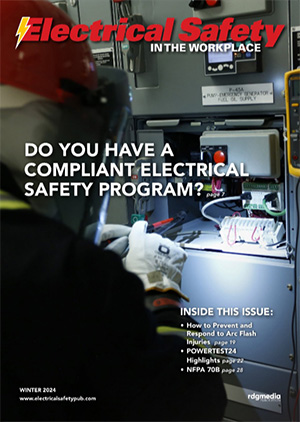Outfitting Electrical PPE The Right Way
A Q&A with Rich Gojdics, Senior Vice President of Sales, National Safety Apparel.
Q: How do we identify potential risks and threats and why is it important to identify these to know the right arc flash and electrical PPE to outfit the worker?
Electricians and qualified workers who approach energized electrical circuits and conductors with the intent to engage these systems face the potential for arc flash and electrical shock hazards while in the process of de-energizing the system to perform maintenance or other tasks. These two hazards are different, and the levels of each hazard vary depending on a series of variables. In order to properly protect the worker from each energy level, some information is necessary to match the PPE to the hazard level. Arc flash energies can be calculated in a variety of ways, or workers can reference the Arc Flash PPE Category Tables for guidance in selecting arc flash protection. Shock hazard levels are simply the voltage present in the circuit, and rubber insulating gloves are classified by maximum voltage each protects to.
Q: Over the past few years, a number of arc rated flame-resistant fabrics have come to market. Why is it important to buy a brand name meeting NFPA 70E PPE CAT2?
This answer has two parts; the minimum threshold to participate in safety PPE is very low and in the case of the Enespro brand, in addition to using branding arc rated FR fabrics, the brand promise is for a better user experience. Workers who like or dislike their PPE have demonstrated over time either strong or weak conformity with the trained rules around when and how to wear their issued PPE.
In order to attain an arc rating, an FR fabric manufacturer only needs to demonstrate that their fabric can be washed a minimum of 25 times before passing the standard vertical flame test. Any fabric passing this minimum threshold can be then tested for the insulative value know as an arc rating, or arc thermal performance value. Given the severity of arc flash events generic fabrics that don’t have the in-service pedigree that the branded AR/FR fabrics have demonstrated over time could be substituted by marginal manufacturers, because they sell products that meet existing minimum requirements for arc flash protection. Most employers therefore seek the data and specify the details of both the fabric and garment manufacturers in their programs.
New technologies by proven FR fabric manufacturers continue to drive a better wearer experience in arc rated daily wear and arc flash PPE. Single and multi-layered combinations of fabrics that are lighter, softer, have better breathability, stretch, and quick-dry attributes are helping deliver better comfort to arc rated apparel and PPE. Enespro took additional steps to solve the age-old problems associated with arc flash PPE by collaborating with hundreds of safety leaders and electricians to re-design suit ensembles that overcome the well-known problems of first-generation electrical PPE.
Q: What types of arc flash and electrical safety needs has the market asked you for and what have you been able to bring to market?
Before Enespro initiated any garment manufacturing, we conducted an extensive research project over a six-month period meeting with hundreds of safety leaders and electricians to understand the top problems workers experience when using arc flash and shock protective PPE. Results of these interviews uncovered user complaints with the categories of head protection, proper PPE storage, rubber insulating gloves, and most significantly, arc flash suits. Limited innovation in the category of arc flash PPE over time means users largely are using similar systems that were introduced to the market ages ago. Throughout the research project users shared new feature ideas or design changes that would solve their personal concerns and improve the products available to their industry. Enespro and National Safety Apparel together have new arc flash PPE and rubber insulating glove options that help create a safer worker. We confidently say this because the outcomes of these design changes have resulted in ensembles workers readily wear comfortably and have proven to also take better care of. When required PPE is acceptable to the worker, the risks of short-cuts and improvising unsafe work practices is mitigated.
Q: What types of arc flash clothing and other products has Enespro innovated?
- Arc flash suits are traditionally heavy and featureless. The Enespro AirLite series in arc-rated levels of 8, 12, and 40-cal suits are both super lightweight and loaded with designs that improve fit, mobility and performance, are easier to don and doff, and include anti-microbial fabrics to reduce offensive odors that are deterrents to proper wear. The National Safety Apparel brand Arc Guard Performance takes weight reduction to the next level, with 40-cal suits that are the lightest in the market, lighter than 12-cal arc flash clothing, and include many of the design options originally added in the Enespro AirLite series.
- The head protection options feature the Vented Lift Front hoods with the first combined fanned options available in the market. With clear-grey visibility and large shields, workers have an unobstructed and undistorted view of their critical work. Also, in researching CAT2 complaints, Enespro developed a one-piece shrouded 12-cal shield that eliminates the opportunity for the worker to skip using the balaclava required to accompany the face shield.
- PPE Storage has not been the focus of manufacturers of electrical PPE. Common storage bags fit the miscellaneous pieces of arc flash ensembles and hoods or shields, but they provide no structural protection for shields or organization of this gear. Users too often open gear bags to access their gear to discover cracked or broken shields. Enespro’s gear bags include a ridged structure within the bag to protect shields while gear bags are in storage, and pockets to isolate rubber gloves to avoid accidental punctures. Recently Enespro’s on-going collaboration with customers resulted in small and large backpack options, that free up the hands of the worker to carry additional gear to remote work.
- Historical Low voltage rubber gloves complaints have been around loss of grip and dexterity, or poor fit and comfort. National Safety Apparel’s acquisitions include a U.S.-made glove capability that delivers a high-quality Class 0 rubber glove that is softer, thinner, and feature a more ergonomically friendly curved finger design that improves the common complaints in fit, grip, and poor dexterity.
Q: Explain the Enespro no-obligation opportunity to trial the Enespro brand of products for 30-days before making a purchasing decision.
It’s understandable that safety leaders are slow to trust new brands and new technologies where the safety of workers could be jeopardized by a decision to purchase an unknown or unproven brand. Enespro realized that this barrier to market pull through for the next generation of electrical PPE could be resolved if prospective customers had an opportunity to take a kit for a closer look by safety stakeholders and worn in the field for a brief period to validate the significance of the improved user experience. At the end of the trial period users are either invoiced or return their demo kits without further obligation. With the rapid market buy-in to the overall value of Enespro PPE, it’s been a low-risk decision to send users a brand-new kit of their choice, without obligation for a 30-day trial where the vast majority of trials result in new program adoptions.
Q: From your perspective, What’s the #1 advantage Enespro now offers since its part of the NSA family of brands?
Before joining forces, National Safety Apparel and Enespro shared many of the same values and complementary strengths. Now that we are all one team, we’ll have an even greater impact on the world of safety. Both companies have built reputations for high quality and innovative safety products that target solving customer problems. Together we will continue innovating to reinvent the user experience around PPE, not only in the arc flash space but other markets such as FR daily-wear and thermal protection. NSA has spent years developing strong relationships with a vast network of distributors that can now bring the Enespro line of innovative safety products to more end users. Enespro had singular focus on the task-based arc flash PPE market, but now as a part of the NSA family we can also bring a much broader offering of innovative products to the customers that have come to know and trust the Enespro brand. ESW
Share on Socials!
NFPA 70E® 2021 for Electrical Safety in the Workplace®
Risk Management in Electrical Utilities: How to Boost Operational Resilience and Respond to Emergencies
All Signs Point to Required Labeling as Key Component of Electrical Workplace Safety
Leaders in Electrical Safety
• Aramark
• Bowtie Engineering
• Enespro
• Ericson
• I-Gard Corporation
• IRISS
• KERMEL, INC.
• Lakeland Industries
• MELTRIC Corporation
• National Safety Apparel
• National Technology Transfer
• Oberon
• Saf-T-Gard
• SEAM Group
Subscribe!
Sign up to receive our industry publications for FREE!







